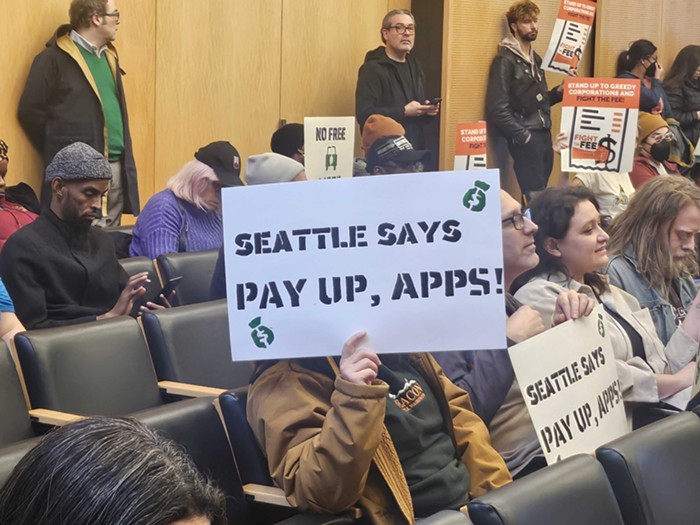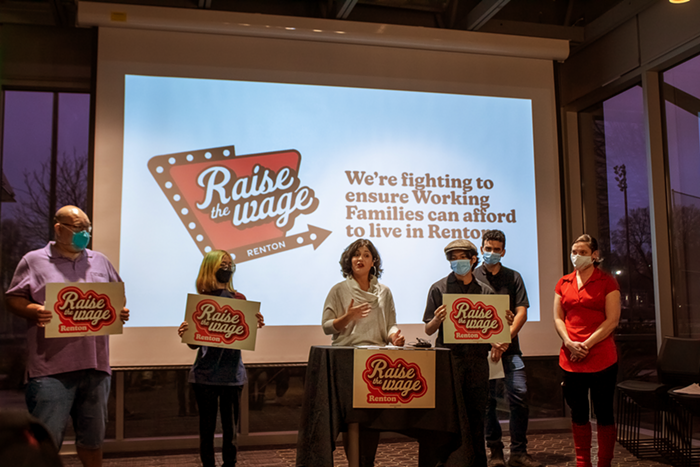The city has been considering for a long, long time how to make sure local workers get hired on publicly funded construction projects, and they're finally getting closer. On some level, it seems like a no-brainer: When tax money goes toward building a community center or a new road surface that costs millions of dollars, that project should result in not just new infrastructure, but good local jobs.
But that's not necessarily what happens. Communities in Seattle started agitating at city hall a few years ago, after watching major public works projects go up while hiring few to no local workers—meaning unemployed Seattleites walked past big job sites in their neighborhoods, funded by public money, being built by contractors who almost exclusively hired from outside the city (or even outside the county).
As I've reported before, a city report found that only 6 percent of workers on the city projects they studied actually lived in Seattle. Only 25 percent even lived in King County. So a city bill to address that, by actually mandating the hiring of locals, has finally been drafted and is being discussed by city council this fall and winter. After a few iterations, it's being called a "Priority Hire" ordinance. With the recommendations of an advisory committee, Mayor Ed Murray supports the current draft of the bill, which focuses on workers from Seattle zip codes with the highest levels of unemployment.
But it's nowhere near finished. A council committee discussion this morning highlighted some really interesting facets of this potential legislation:
FUTURE COST SAVINGS
Policy staffers for the city seemed to be predicting some outcry about how a new mandate might affect the cost of city projects. And they have an interesting answer to that: They believe it will help control costs in the future. How? Because, according to studies commissioned by the city as they've looked into this issue, there's predicted to be a bit of a labor shortage in the next few years. When there's a labor shortage, labor costs go up, driving up the costs of public projects. And so, because this Priority Hire legislation would come with a host of investments in the construction career pipeline of education, training, pre-apprenticeship, and apprenticeship, then help to make sure those workers get hired, they expect it will create a better labor market in the future, therefore saving the city money down the road (while also helping local workers get good jobs now).
UNION VS. NONUNION CONTRACTORS
This is the real sticking point. The mechanism by which this mandate for local hires would actually happen is something called a Project Labor Agreement (PLA), which is a negotiation, usually with unions, that governs things like hiring on the project. In this case, the city would negotiate an agreement with provisions on how to ensure the hiring of some local workers and what the specific goals or requirements would be for that project. But lots of people, including members of the original advisory committee, have said that could pose problems, since requiring an agreement with labor seems to exclude nonunion contractors. Contractors who were on the committee issued a minority report saying requiring a PLA would hurt the many "open shop" contractors. This debate is still going strong, as evidenced by public comments today.
DETAILS STILL MURKY
This ordinance leaves a lot of specifics up to a city director, who would set these hiring goals and help negotiate these agreements. That's because mandating an across-the-board policy or percentage gets really tricky with all the different kinds of workers involved in a big project, who are all in the construction industry but whose particular jobs (electricians, crane operators, what-have-you) can have very different workforces. And different city projects can vary wildly in size and scope and content. (This would kick in for any project of $5 million or more.) So it seems the council has shied away from the idea of putting into law, right now, a particular percentage of local workers required on these projects, in favor of a nimble, flexible response to changing conditions. Which means a lot of the details that might make this program a success or a failure aren't really on the table yet. The city will have a lot of follow-up work to do to see how everything's working.
Council Member Sally Clark, whose committee is considering the legislation, says the next discussion won't be until December 4, after budget season, and a vote could come as late as January of next year. Stay tuned.


















